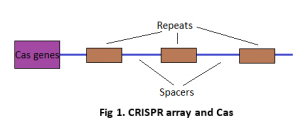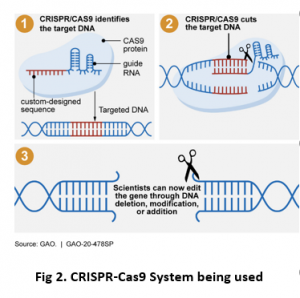Introduction:
The goal of this week’s assignment is to write a parenthetical, sentence, and expanded definition of a complex term that is specific to our respective fields. The purpose of this is for us to appreciate how the complexity of a definition is dependent on the audience we are communicating with. My previous degree was in Biology, so I chose a term from this field, as I am most comfortable with it. The term I will be delving into is Clustered regularly interspaced short palindromic repeats cas9 system (shortened as CRISPR-Cas9), which is a technique that can be used in gene editing.
Term:
Clustered regularly interspaced short palindromic repeats cas9 system (CRISPR-Cas9)
Situation:
A marketing director wants to convince a board of investors to invest into something in the Biological Sciences that can have a high return on investment. This person will now have to learn more about CRISPR-Cas9, in order to make the case to the board.
Parenthetical Definition:
Biotechnology companies in agriculture often make use of CRISPR-Cas9 to change the genetics of crops, such as making them more resistant to pests.
Sentence Definition:
CRISPR-Cas9 is a genetic engineering technique, adopted from bacterial cells, that is now being used to modify the genes of plants, animals, and even humans.
Expanded Definition:
Genome editing, also known as gene editing, consists of several technologies that grant scientists the ability to alter an organism’s DNA. CRISPR-Cas9 is a very recent instance of such a technology, which offers vastly greater accuracy as compared to older methods.
DNA is simply a set of hereditary instructions that determine almost all the characteristics of a living thing. These instructions come in the form of a sequence of letters: A, G, T, and C. RNA is almost identical but differs in a single letter. We can think of genes as functional units of DNA, that when ‘read’, eventually go on to produce proteins; a fundamental building block of all life.
The CRISPR-Cas9 system was first identified by Francis Mojica as a naturally occurring system in bacteria. It’s composed of two parts; a CRISPR array, and a Cas9 system. The array itself consists of palindromic repeats of the letters of DNA as mentioned previously, and unique spacers in between these repeats.
The Cas genes identified in the figure will make Cas proteins that cut DNA, permitting modification. Interestingly the unique spacers match up exactly to viral DNA. This is because, in a bacterium, snippets of DNA from invading viruses are captured, and using Cas proteins, incorporated into the CRISPR array as a spacer between repeats.
This allows the bacteria to “remember” the viruses, analogous to how our immune system works but at a far smaller scale. If a future viral attack occurs, RNA segments from spacers specific to the virus will be produced and attach to the Cas9 protein. These will help “guide” the Cas9 to the viral DNA, which will then be cut and disabled by Cas9.
This naturally occurring system was modified so that we could use it to target DNA of our choice, rather than viral DNA. In the lab, researches create a small piece of RNA with our desired sequence and a short “guide” that attaches to our target sequence in DNA. This RNA, along with its guide, will bind to the Cas9 protein (1). Like the mechanism in bacteria, the guide will attach to the DNA target, allowing the Cas9 protein to cut the site (2). Following the cut, our desired sequence is inserted (3).
Therein lies the marvel of CRISPR-Cas9. In being able to make use of this technique to modify our genes, we can alter these fundamental building blocks in far-reaching ways. Most notably, to eliminate diseases that have a genetic basis of origin, such as cystic fibrosis, hemophilia, and muscular dystrophy. In addition, genetic intervention in more complex diseases with some genetic causes, such as cancer, heart disease, and Alzheimer’s is also a possibility.
Works Cited
Andersen, P. (Director). (2016, February 18). What is CRISPR? [Video file]. Retrieved September 30, 2020, from https://www.youtube.com/watch?v=MnYppmstxIs
Office, U. (2020, April 07). Science & Tech Spotlight: CRISPR Gene Editing. Retrieved September 30, 2020, from https://www.gao.gov/products/GAO-20-478SP
Scarpelli, D., & Burrows, W. (2020, April 01). Diseases of genetic origin. Retrieved September 30, 2020, from https://www.britannica.com/science/human-disease/Diseases-of-genetic-origin
What are genome editing and CRISPR-Cas9? – Genetics Home Reference – NIH. (n.d.). Retrieved September 30, 2020, from https://ghr.nlm.nih.gov/primer/genomicresearch/genomeediting
What is DNA? -. (2016, April 21). Retrieved September 30, 2020, from http://www.sciencemadesimple.co.uk/curriculum-blogs/biology-blogs/what-is-dna


Leave a Reply